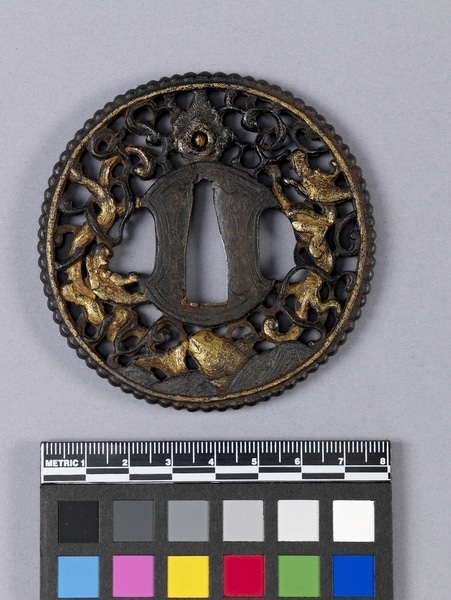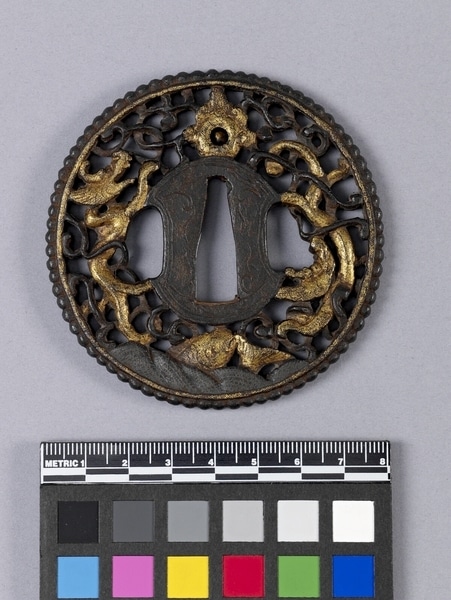Sword Guard Item Number: Ed5.3141 from the MOA: University of British Columbia


Description
Circular, metal sword guard with circular shape, triangular hole at centre, and ovoid holes to either side. Edge is ribbed. Low relief motifs both front and back include waves and carp at bottom, writhing dragons on either side, and a pearl above which moves freely within a flaming halo. The carp, dragons and pearl are overlaid with gold and all connected by openwork vines which are undercut. Ana, copper insert at base; seppa dai, undecipherable characters. Incised; both kogai and kodzuka openings.
History Of Use
Tsuba are placed between the hilt and blade of a sword, forming an essential guard for the hand. Known to exist in Japan at least since the 8th century, they were plain unsigned metal until about the 16th century, when they became enriched artistic expressions usually made to the order of the individual warrior. The central opening, nakago ana, holds the tang of the blade and often has chisel marks or soft metal inserts as adjustments. It is surrounded by a plain surface, the seppa dai, on which the artist's signature may be found. On either side are the kodzuka and kogai openings, for a knife and a skewer respectively; when both are open the guard is intended for a wakazashi blade (less than two feet) and when one or both are plugged or absent the guard is probably intended for the longer katana blade.
Narrative
Marion Stephan Collection. This style of guard is known Namban. The motifs usually derive from the possessions or persons of Chinese, Dutch, or Portuguese merchants trading into Japan in the late 16th and 17th centuries. 'Iron' strictly speaking is a pure metal never encountered in antiquity. It's alloys, whether natural or deliberate, are really forms of steel. There is a long tradition in the literature, however, of referring to the material of a major number of tsuba as iron, which is adhered to in the present catalogue.
Iconographic Meaning
Two dragons chasing a 'flaming pearl' are common Chinese motifs. Dragons are powerful benevolent creatures; there are many explanations of the pearl , including that to lose it is to lose power. A carp is the sign both of a male and of a scholar.
Item History
- Made in Japan between 1700 and 1800
- Collected between 1935 and 1940
- Owned by Marion Stephan
- Owned by Charles H. Stephan before January 10, 1977
- Received from Charles H. Stephan (Donor) on January 10, 1977
What
- Name
- Sword Guard
- Identification Number
- Ed5.3141
- Type of Item
- guard
- Material
- iron metal, copper metal and gold metal
- Manufacturing Technique
- forged, chiseled, overlaid and incised
- Overall
- height 0.5 cm, diameter 7.3 cm
Who
- Culture
- Japanese
- Previous Owner
- Marion Stephan and Charles H. Stephan
- Received from
- Charles H. Stephan (Donor)
Where
- Holding Institution
- MOA: University of British Columbia
- Made in
- Japan
When
- Creation Date
- between 1700 and 1800
- Collection Date
- between 1935 and 1940
- Ownership Date
- before January 10, 1977
- Acquisition Date
- on January 10, 1977
Other
- Item Classes
- metalwork
- Condition
- good
- Current Location
- Case 79
- Accession Number
- 0352/0263